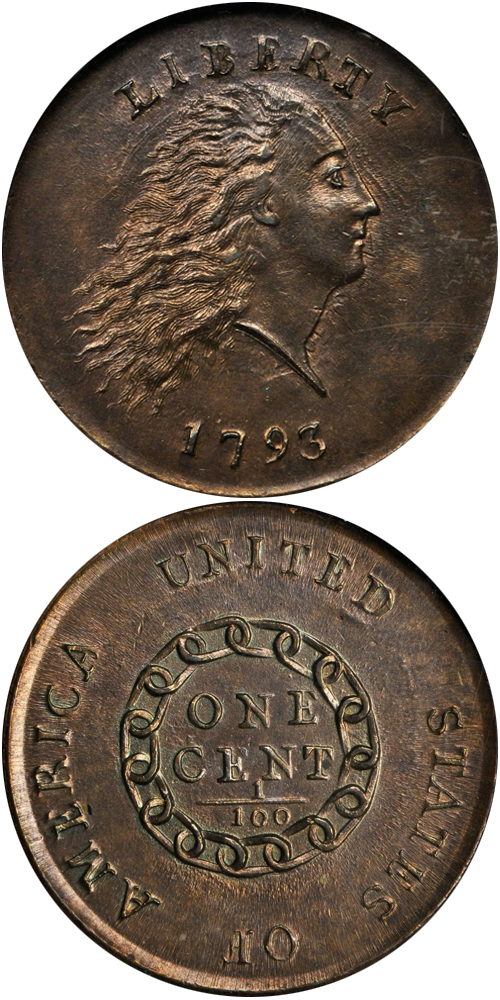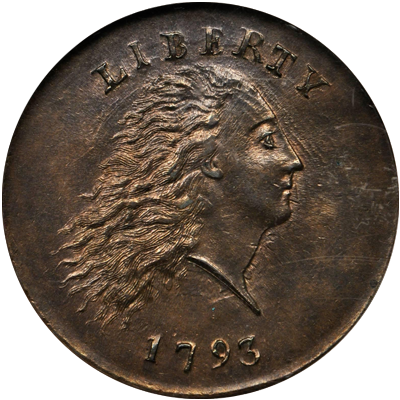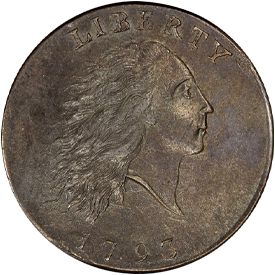Designed by: Henry Voigt
Issue Date: 1793
Composition: Copper
Diameter: Average 26 to 27 mm
Weight: 13.47 grams (208 grains)
Edge: Vine and bars design
Business Strike Mintage: 36,103
Proof Mintage: None
This, the first American cent made for general circulation, depicts on the obverse Miss Liberty facing right, with LIBERTY above and the date 1793 below. The reverse illustrates a link chain motif at the center, enclosing ONE CENT and the fraction 1/100, while at the outer border is UNITED STATES OF AMERI. on the first variety minted (Sheldon die variety No. 1) and UNITED STATES OF AMERICA on others. The border consists of a rim without beads or denticles. Appearing early in the year, the "Chain cent" evoked unfavorable criticism, with one newspaper report stating that Miss Liberty appeared to be "in a fright" and that the chain motif on the reverse was but an ill omen for a country which had recently secured its freedom (from England). The criticism was heeded, and before long the Chain design was discontinued.
Specimens today are scarce in all grades. The obverse design details were lightly cut into the dies, and the result is that only the highest-grade pieces are apt to show well defined strands of Miss Liberty's hair in the central portions. It is often the case that the obverse of a given piece will be a grade or two less than the reverse. Examples are most frequently seen in lower grades, from Fair through Good to Very Good. Fine to Very Fine pieces are elusive, while examples in Extremely Fine or better preservation are very rare.
Further Reading
The very first United States cent variety is that known today as Sheldon-1, abbreviated as S-1 by collectors, the Chain cent with AMERICA appearing on the reverse as AMERI. The engraver of this coin, fearful that the entire word would not be able to fit correctly, shortened it in this unusual manner.
It is not known who engraved the dies for the first cent. For many years it was reiterated in numismatic publications that the Chain cent was the work of Jean Pierre Droz, a Swiss, but in later years the theory was discarded. In his magnificent book, United States Mint and Coinage, Don Taxay quotes extensively from Droz' correspondence, who during the time involved was in France and England immersed in the preparation of dies and the intricacies of coinage machinery. Despite several enticements, Droz apparently did not engrave any United States coinage dies. However, he did make many dies for pattern halfpennies and other English pieces. The workmanship on these is far, far superior to that used on United States coins of the era – and for this reason alone Droz' participation can be discounted. Indeed, Dr. Sheldon observes this. In more recent times Henry Voigt has been named as the designer and possibly the engraver.
In the numismatic world one person's opinion often is changed in print to another person's theory, to be reprinted still later as a fact. Thus, many statements which appear in reference books today, items such as identification of precise engravers with certain coins, and the breaking down of yearly mintage types into specific designs or varieties, are simply opinions that may or may not conform to the facts, could they be learned. It might have been done translates all too readily into it was done.
Following the beginning AMERI. strikings, several other varieties of Chain cents, these latter with the word AMERICA spelled out in full, were produced. The other notable variety has periods after the date and the word LIBERTY. Today, most collectors group AMERI. and AMERICA varieties together as a general design type.
The reaction of the public to the 1793 Chain design was unfavorable. One newspaper account noted that Miss Liberty appeared to be "in a fright" and that the depiction of a chain on the reverse was "but an ill omen for liberty" and was scarcely emblematic of a country which had just gained its freedom. Soon, Mint officials directed that a new design be prepared. A Guide Book of United States Coins lists a mintage of 36,103 examples of the Chain design of which it is believed that just under one third were of the AMERI. variety.
Today Chain cents are highly desired. Several hundred specimens exist of the various die varieties. Typically, pieces seen are in lower grades, ranging from Fair (sometimes with just the central devices on the obverse and reverse visible, the date long since having been worn away) to Fine. The relief of the dies was such that even higher-grade examples tend to look much more worn than they actually are. Often a piece will have a relatively sharp reverse, particularly the chain motif, but the obverse will be quite weak and indistinct at the center. Very Fine and Extremely Fine Chain cents are encountered when major collections come on the market. A few scattered Uncirculated pieces exist and are objects of desire, mostly unrequited, by specialists in the series, even those with the most generously endowed checking account balances. The acquisition of such a piece is related more to opportunity than to financial ability.








